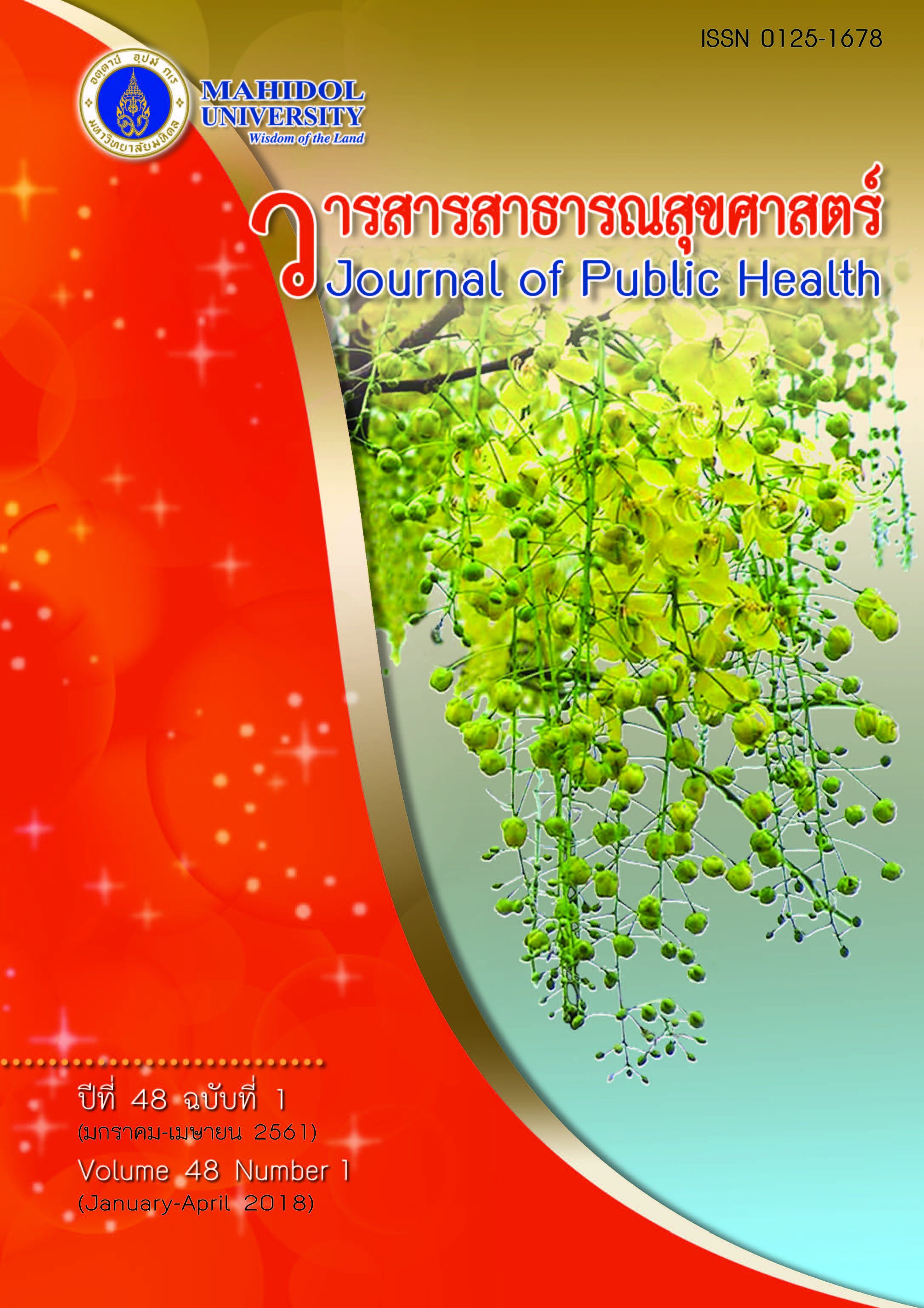การเปรียบเทียบเกณฑ์การแปลผลการตรวจสมรรถภาพปอดด้วยวิธีสไปโรเมตรีย์ ในงานอาชีวอนามัยของประเทศไทย
Keywords:
สไปโรเมตรีย์, วิธี Specified Ratio, วิธี Lower Limit of the Normal(LLN), อาชีวอนามัย, spirometry, specified ratio of predicted value (SPV), lower limit of the normal (LLN), occupational healthAbstract
ประเทศไทยมีแนวทางการแปลผลสมรรถภาพปอดด้วยวิธีสไปโรเมตรีย์หลายแนวทาง และไม่มีข้อสรุปที่แน่ชัด การแปลผลต่างกันอาจทำให้เกิดความเข้าใจไม่ตรงกันและไม่สามารถนำผลมาเปรียบเทียบกัน การวิจัยนี้จึงมีวัตถุประสงค์เพื่อเปรียบเทียบความสอดคล้องของวิธี Specified Ratio แต่ละแนวทางในประเทศไทย กับเกณฑ์มาตรฐานวิธี Lower Limit of the Normal (LLN) เป็นการศึกษาเชิงพรรณนา ในผู้เข้ารับการตรวจสมรรถภาพปอด คลินิกโรคจากการประกอบอาชีพ โรงพยาบาลระยอง พ.ศ. 2559 จำนวน 1,295 คน วิเคราะห์ข้อมูลโดยสถิติค่าเฉลี่ย ความถี่ ร้อยละ ส่วนเบี่ยงเบนมาตรฐาน และวิเคราะห์ความสอดคล้อง ด้วยสัมประสิทธิ์ Kappa Coefficient ผลการศึกษาพบว่า ความสอดคล้องของ FEV1 และ FVC ซึ่งมีจุดตัดเหมือนกันทุกแนวทางมีความสอดคล้องดีมาก (0.88) และดี (0.78) ตามลำดับ FEV1/FVC ของแนวทางสมาคมโรคจากการประกอบอาชีพและสิ่งแวดล้อมแห่งประเทศไทย พ.ศ. 2557 มีความสอดคล้อง (0.63) น้อยกว่าแนวทางจากหนังสือประกอบการฝึกอบรมเจ้าหน้าที่ของสมาคมอุรเวชช์ ปี พ.ศ. 2551 (0.87) และ ปี พ.ศ. 2556 (0.84) เมื่อกำหนดจุดตัด FEV1/FVC น้อยกว่า 90% Predicted ถือว่า ผิดปกติ พบว่า ความสอดคล้องอยู่ในระดับดี (0.82) ดังนั้นการตรวจคัดกรองสมรรถภาพปอดในทางอนาชีวอนามัย หากมีการปรับเกณฑ์จุดตัดของ FEV1/FVC ตามแนวทางจากหนังสือประกอบการฝึกอบรมเจ้าหน้าที่ของสมาคมอุรเวชช์ ปี พ.ศ. 2551 จะได้ค่าความสอดคล้องดีที่สุดเมื่อเทียบกับวิธี LLN
Comparison of Spirometry Interpretative Methods in an Occupational Health Setting, Thailand
In Thailand, spirometric interpretation in an occupational health setting is inconclusive due to the availability and use of multiple guidelines. The purpose of this descriptive study was to compare the degree of agreement between the interpretations of spirometry using SPV guidelines from several organizations. These included 1) the Association of Occupational and Environmental Diseases of Thailand (AOEDT), Version 2014, 2) training manual from the Thoracic Society of Thailand under Royal Patronage (TST), Version 2008 and 2013 and 3) lower limit of normal (LLN) calculated from reference equations for the Thai population. Study populations comprised 1,295 subjects who visited the occupational clinic at Rayong Hospital in 2016. Data were analyzed using frequency, percentage, standard deviation and inter-rater agreement was calculated as a kappa score. FEV1 and FVC using all SPV guidelines resulted in good agreement (0.8 and 0.78), respectively. However, FEV1/FVC ratios interpreted from AOEDT guidelines, Version 2014, led to poor agreement with LLN (0.63). When FEV1/FVC ratios were interpreted by cut-off values from guidelines of TST, Version 2008 and 2013, agreement improved to 0.87 and 0.84, respectively. Moreover, when cut-off values for SPV were modified to 90% of predicted values for FEV1/FVC ratios, agreement would improve to 0.82. In conclusion, interpreting the pulmonary function test using spirometry for occupational health screening with cut-off values of 80% predicted FVC and FEV1 results in good agreement with LLN. However, when the SPV cut-off values for FEV1/FVC ratios by AOEDT 2014 were modified to cut-off values of TST 2008, agreement and validity with LLN was improved.
Downloads
Published
Issue
Section
License
Creative Commons License CC-BY-ND


